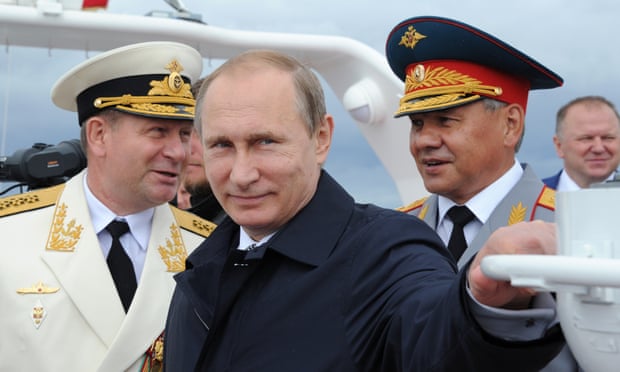Russia appears to have upgraded a nuclear weapons storage bunker in its Kaliningrad enclave, in the latest sign of Moscow’s increased emphasis on nuclear arms in its standoff with Nato, according to a new report.
The Federation of American Scientists (FAS) has published satellite images which the group says show a storage facility in the Baltic coast enclave between Poland and Lithuania being deepened and then covered with a new concrete roof in recent months.
“It has all the fingerprints of typical Russian nuclear weapons storage sites,” said Hans Kristensen, the director of the nuclear information project at FAS. “There is a heavy-duty external perimeter of multilayered fencing. The bunkers themselves have triple fencing around them as well. These are typical features from all the other nuclear weapons storage sites that we know about in Russia.”
The work on the bunker began in 2016, and the new roof was put on earlier in the summer.
“It’s a site we have been monitoring for quite some time and there have been and there have been some upgrades in the past but nothing as dramatic as this one. This is the first time we’ve seen one of the nuclear bunkers being excavated and apparently renovated,” Kristensen said.
“These pictures don’t prove that there are nuclear weapons in Kaliningrad now, but they do show it is an active site,” Kristensen said.
He said it was unclear whether the Russian military already had nuclear warheads at the site, or that they are about to bring them in, or whether the facility was being upgraded so that nuclear weapons could be moved in at short notice.
Kaliningrad, formerly the East Prussian outpost of Königsberg, is currently in the public eye as one of the venues for the football World Cup. It is also emerging as a critical square on the east European chessboard in Vladimir Putin’s efforts to push back assertively against Nato expansion.
The Russian military announced in January this year that the necessary infrastructure had been built to accommodate a permanent presence of mobile Iskander-M missiles, capable of carrying conventional and nuclear warheads a range of 500km. The missiles were due to be combat ready early this year.
The US says that because of their range, the Iskanders represent a violation of the 1987 Intermediate-range Nuclear Forces treaty.
Kaliningrad also serves as a base for Russia’s Baltic fleet.
Unlike Nato, the Russian military, particularly its navy, has kept many of its tactical weapons systems nuclear capable, including anti-ship missiles, short range land-attack missiles and even air defences.
As tensions with the west have escalated over Ukraine and Syria, Putin has put more emphasis on Russia’s nuclear arsenal. In March this year, Putin unveiled a range of new nuclear weapon designs which he claimed could overcome any western defences.
Kristensen said it was unclear what kind of warheads the renovated bunker in Kaliningrad is meant to serve, but it is much closer to the naval base than the missile base, which is further inland.
Original Article
Source: theguardian.com
Author: Julian Borger
The Federation of American Scientists (FAS) has published satellite images which the group says show a storage facility in the Baltic coast enclave between Poland and Lithuania being deepened and then covered with a new concrete roof in recent months.
“It has all the fingerprints of typical Russian nuclear weapons storage sites,” said Hans Kristensen, the director of the nuclear information project at FAS. “There is a heavy-duty external perimeter of multilayered fencing. The bunkers themselves have triple fencing around them as well. These are typical features from all the other nuclear weapons storage sites that we know about in Russia.”
The work on the bunker began in 2016, and the new roof was put on earlier in the summer.
“It’s a site we have been monitoring for quite some time and there have been and there have been some upgrades in the past but nothing as dramatic as this one. This is the first time we’ve seen one of the nuclear bunkers being excavated and apparently renovated,” Kristensen said.
“These pictures don’t prove that there are nuclear weapons in Kaliningrad now, but they do show it is an active site,” Kristensen said.
He said it was unclear whether the Russian military already had nuclear warheads at the site, or that they are about to bring them in, or whether the facility was being upgraded so that nuclear weapons could be moved in at short notice.
Kaliningrad, formerly the East Prussian outpost of Königsberg, is currently in the public eye as one of the venues for the football World Cup. It is also emerging as a critical square on the east European chessboard in Vladimir Putin’s efforts to push back assertively against Nato expansion.
The Russian military announced in January this year that the necessary infrastructure had been built to accommodate a permanent presence of mobile Iskander-M missiles, capable of carrying conventional and nuclear warheads a range of 500km. The missiles were due to be combat ready early this year.
The US says that because of their range, the Iskanders represent a violation of the 1987 Intermediate-range Nuclear Forces treaty.
Kaliningrad also serves as a base for Russia’s Baltic fleet.
Unlike Nato, the Russian military, particularly its navy, has kept many of its tactical weapons systems nuclear capable, including anti-ship missiles, short range land-attack missiles and even air defences.
As tensions with the west have escalated over Ukraine and Syria, Putin has put more emphasis on Russia’s nuclear arsenal. In March this year, Putin unveiled a range of new nuclear weapon designs which he claimed could overcome any western defences.
Kristensen said it was unclear what kind of warheads the renovated bunker in Kaliningrad is meant to serve, but it is much closer to the naval base than the missile base, which is further inland.
Original Article
Source: theguardian.com
Author: Julian Borger

No comments:
Post a Comment